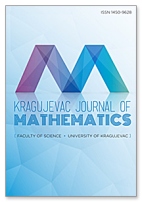Computing the $\mathcal{H}_2$-Norm of a Fractional-Order System Using the State-Space Linear Model
 Download PDF
Download PDF
Authors: A. LAKEB, Z. KAISSERLI AND D. BOUAGADA
DOI: 10.46793/KgJMat2304.531L
Abstract:
The main purpose of the present paper is to establish an alternative approach to compute the ℋ2-norm for a fractional-order transfer function of the first kind based on Caputo fractional derivative. The key idea behind this new approach is the use of the concept of the parahermitian transfer matrices and the state-space realization. Numerical examples are presented to illustrate the new approach.
Keywords:
Fractional-order differentiation, fractional transfer function of the first kind, ℋ2-norm, parahermitian transfer matrices, state-space linear model, transformation matrices.
References:
[1] K. J. Aström, Introduction to Stochastic Control Theory, Academic Press, New York, 1970.
[2] D. Bouagada, S. Melchior and P. Van Dooren, Calculating the ℋ∞-norm of a fractional system given in state-space form, Appl. Math. Lett. 79 (2018), 51–57. https://doi.org/10.1016/j.aml.2017.11.019
[3] R. Caponetto, G. Dongola, L. Fortuna and I. Petras, Fractional Order Systems: Modeling and Control Applications, World Scientific, Singapore, 2010. https://doi.org/10.1142/7709
[4] M. Caputo, Elasticità e Dissipazione, Zanichelli, Bologna, 1969.
[5]
G. Doetsch, Handbuch der Laplace-Transformation, Birkh user,
Basel, 1950. https://doi.org/10.1007/978-3-0348-6984-3
user,
Basel, 1950. https://doi.org/10.1007/978-3-0348-6984-3
[6] Y. Genin, Y. Hachez, Y. Nesterov, R. Stefan, P. Van Dooren and S. Xu, Positivity and linear matrix inequalities, Eur. J. Control 8(3) (2002), 275–298. https://doi.org/10.3166/ejc.8.275-298
[7] W. K. Grawronski, Advanced Structural Dynamics and Active Control of Structures, Mechanical Engineering Series, Springer-Verlag, New York, 2004. https://doi.org/10.1007/978-0-387-72133-0
[8] T. Kaczorek and K. Rogowski, Fractional Linear Systems and Electrical Circuits, Studies in Systems, Decision and Control 13, Springer International Publishing, Switzerland, 2015. https://doi.org/10.1007/978-3-319-11361-6
[9] A. A. Kilbas, H. M. Srivastava and J. J. Trujillo, Theory and Applications of Fractional Differential Equations, Elsevier, Amsterdam, 2006. https://doi.org/10.1016/S0304-0208(06)80001-0
[10] R. Malti, M. Aoun, F. Levron and A. Oustaloup, Analytical computation of the ℋ2-norm of fractional commensurate transfer functions, Automatica 47 (2011), 2425–2432. https://doi.org/10.1016/j.automatica.2011.08.021
[11] C. A. Monje, Y. Q. Chen, B. M. Vinagre, D. Xue and V. Feliu, Fractional-Order Systems and Controls: Fundamentals and Applications, Advances in Industrial Control, Springer-Verlag, London, 2010. https://doi.org/10.1007/978-1-84996-335-0
[12] I. Podlubny, Fractional Differential Equations, Academic Press, New York, 1998.
[13] S. G. Samko, A. A. Kilbas and O. I. Marichev, Fractional Integrals and Derivatives: Theory and Applications, Gorden and Breach Science Publisher, Amsterdam, 1993.
[14] R. Toscano, Structured Controllers for Uncertain Systems: A Stochastic Optimization Approach, Advances in Industrial Control, Springer-Verlag, London, 2013. https://doi.org/10.1007/978-1-4471-5188-3
[15] D. Valério and J. S. da Costa, An introduction to Fractional Control, The Institution of Engineering and Technology, London, 2013. https://doi.org/10.1049/PBCE091E
[16] G. Verghese, P. Van Dooren and T. Kailath, Properties of the system matrix of a generalized state-space system, Internat. J. Control 30(2) (1979), 235–243. https://doi.org/10.1080/00207177908922771
